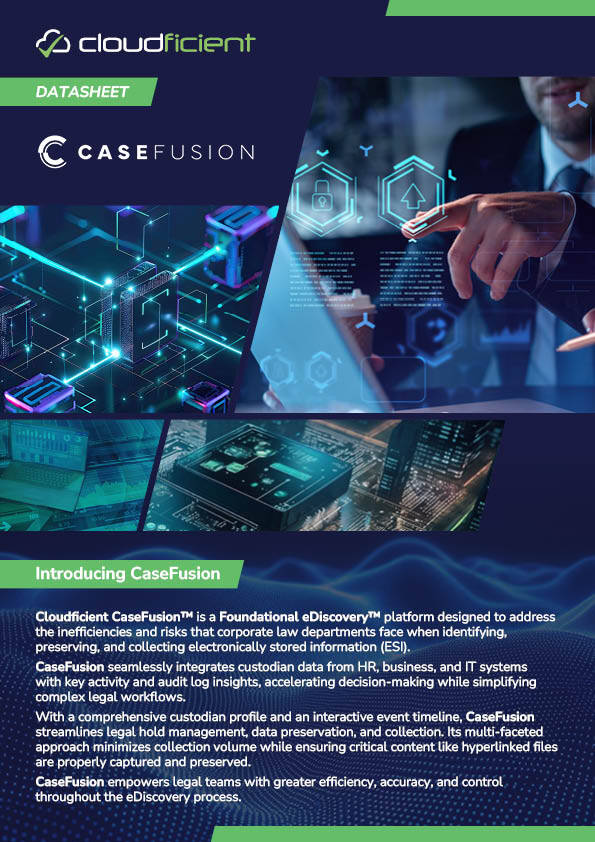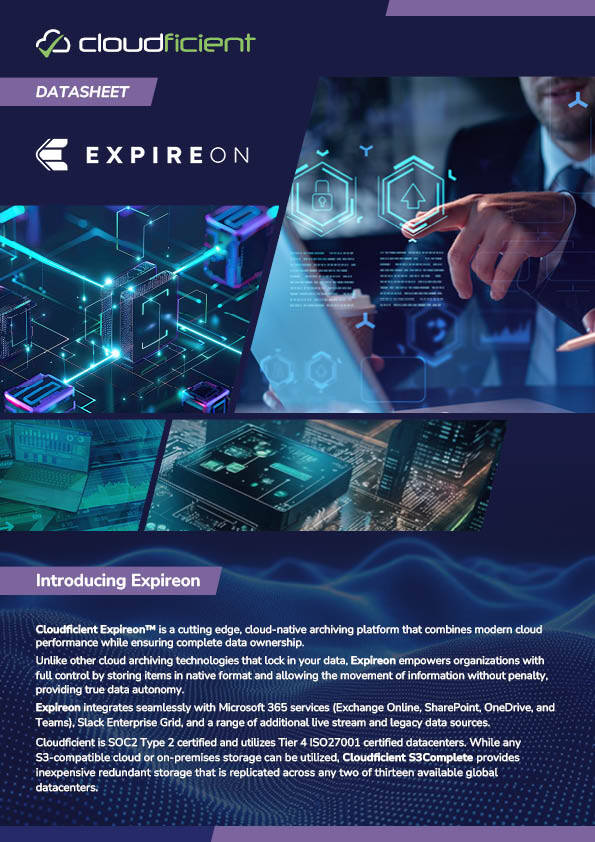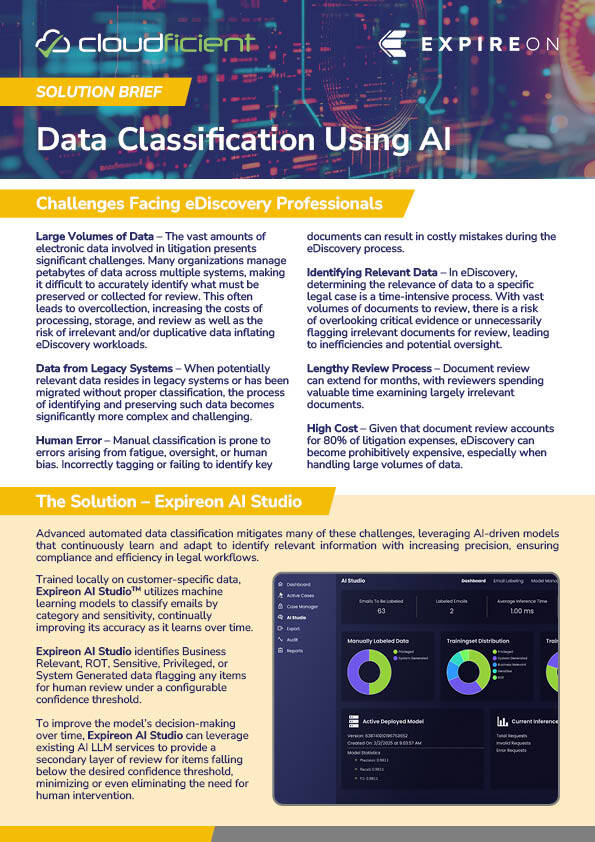- Solutions
- Foundational eDiscovery
Foundational eDiscovery: Improving Electronic Discovery from the Start
Legal teams need to be prepared to navigate a storm of technological complexity, regulatory pressure, and resource constraints that make effective eDiscovery more challenging than ever before. Traditional eDiscovery tools often break down when confronted with maintaining defensible processes while managing expanding data volumes, diverse data sources, and sophisticated legal requirements often across multiple jurisdictions. Organizations require comprehensive eDiscovery solutions that leverage advanced eDiscovery technology to ensure defensible processes throughout the discovery lifecycle.
What is Foundational eDiscovery?
Foundational eDiscovery refers to the identification, preservation, and collection phases of the Electronic Discovery Reference Model (EDRM). These phases are necessary for all types of matters, ranging from litigation to privacy to breach response. Cloudficient believes that by performing these critical stages efficiently, organizations create a foundation upon which the rest of the legal data process can be streamlined.
If you would like to learn more, check out our book Foundational eDiscovery: A Practical Guide to Early Case Management.
The Growing Complexities of Modern eDiscovery
Effective eDiscovery is more challenging than ever before due to technological complexity, regulatory pressure, and resource constraints. Without integrated eDiscovery platforms that provide unified workflows, teams face fragmented processes that compromise efficiency, defensibility, and case outcomes.
Volume and Data Growth Overwhelm Traditional Processes
Enterprise data volumes continue to grow exponentially, creating unprecedented challenges for eDiscovery workflows. Organizations can generate terabytes of new data monthly across email, collaboration platforms, cloud storage, and mobile devices, none of which can be efficiently managed through traditional discovery methods. This creates significant operational challenges with:
-
Rising storage costs: Data preservation requirements force organizations to maintain vast archives of potentially relevant information, driving storage costs higher while creating downstream processing bottlenecks.
-
Processing time delays: Large data volumes require extended processing times that delay case timelines and increase legal risk during time-sensitive litigation matters. Legacy eDiscovery tools often lack the processing capacity needed for modern data volumes.
-
Review cost inflation: Massive data sets force legal teams to review more documents than ever, increasing the time and costs of review. Without efficient eDiscovery technology, organizations face unsustainable review expenses.
-
Infrastructure strain: Legacy eDiscovery systems often lack the capacity to handle modern data volumes, creating system failures and processing delays that compromise case outcomes.
These volume challenges force legal teams to make difficult decisions between thorough electronic discovery and cost control, often resulting in incomplete data collection or unsustainable legal expenses.


Data Source Complexity Creates Integration Blind Spots
Modern enterprises operate across fragmented technology ecosystems where critical information must be collected from multiple platforms while maintaining integrity, completeness, and defensibility. Organizations typically manage data across Microsoft 365, Slack, legacy archives, acquired company systems, and cloud platforms, none of which offer unified eDiscovery workflows. This fragmentation creates significant risks, including:
-
Platform-specific limitations: Each system requires different collection procedures, leading to inconsistent data formats and metadata preservation that complicate review processes. Modern eDiscovery solutions need to bridge these platform gaps.
-
Integration gaps: Relationships between systems are often invisible during eDiscovery, resulting in incomplete datasets that threaten legal defensibility and case outcomes. Comprehensive eDiscovery platforms provide unified data visibility.
-
Legacy system complexity: Outdated databases and file servers contain crucial historical information but lack modern eDiscovery capabilities that support efficient collection and processing workflows. Advanced eDiscovery tools can bridge these legacy gaps.
-
Cloud sprawl challenges: SaaS applications often sit outside IT oversight, leaving gaps in eDiscovery scope that often surface during litigation. Integrated eDiscovery technology addresses cloud complexity.
These integration challenges force legal teams to work with incomplete datasets, increasing the risk of missing key evidence and compromising case strategies.
Technical and Infrastructure Issues Undermine Defensibility
Organizations struggle with technical infrastructure that can’t support modern eDiscovery requirements, creating defensibility gaps and operational failures. Legacy systems, inadequate processing capacity, and integration challenges combine to create significant technical risks that modern eDiscovery platforms must address, like:
-
System compatibility failures: Disparate eDiscovery tools often can’t communicate effectively, creating data silos and workflow bottlenecks that delay case progress. Unified eDiscovery solutions eliminate these integration challenges.
-
Processing capacity limitations: Insufficient technical infrastructure leads to processing delays, system crashes, and incomplete data collections that can expose organizations to discovery sanctions. Modern eDiscovery technology provides scalable processing power.
-
Metadata preservation gaps: Technical failures during collection and processing can corrupt or lose critical metadata, undermining document authenticity and admissibility. Advanced eDiscovery platforms maintain metadata integrity.
-
Backup and recovery challenges: Inadequate disaster eDiscovery planning for eDiscovery systems introduces substantial risks because of the risk of technical failure during litigation. Enterprise SaaS eDiscovery solutions need to be robust.
Without the strong bedrock of solid technical infrastructure, organizations face increased litigation risk through incomplete data preservation and compromised evidence integrity.


Legal and Compliance Pressures Demand Precision
Evolving legal requirements and regulatory frameworks create complex compliance challenges that traditional eDiscovery approaches can’t address effectively. Organizations need to be prepared to navigate multiple jurisdictions, changing privacy laws, and increasing court scrutiny while maintaining defensible processes, or they risk:
-
Regulatory complexity: GDPR, CCPA, and other privacy regulations can create conflicting requirements, complicating cross-border eDiscovery and data handling procedures.
-
Court scrutiny intensification: Judges are creating increasingly higher standards for defensibility and documentation that many organizations struggle to meet.
-
Elevated sanction risk: Failed eDiscovery processes result in severe sanctions, including adverse inference instructions that can determine case outcomes and monetary penalties that can undermine them.
-
Privilege protection challenges: Complex privilege rules across jurisdictions require sophisticated screening processes that many organizations lack, creating inadvertent disclosure risks.
These legal pressures demand precision and documentation that can’t be provided by traditional eDiscovery approaches, exposing organizations to significant litigation risks.
Best Practices for Foundational eDiscovery
To achieve sustainable eDiscovery success and maintain a competitive advantage, organizations must implement comprehensive best practices that address the most common challenges in eDiscovery management and ensure compliance with evolving legal requirements.
Utilize Strategic Planning and Governance
Establish comprehensive eDiscovery governance frameworks that align with organizational objectives while ensuring consistent, defensible processes across all matters. Create detailed policies that define data retention schedules, legal hold procedures, and preservation protocols for structured and unstructured data sources. Strategic governance frameworks prevent costly spoliation claims while ensuring rapid response capabilities when litigation or regulatory investigations arise. Organizations require centralized governance platforms that provide automated policy enforcement and comprehensive audit trails to demonstrate compliance with legal and regulatory requirements.
Carefully Select Electronic Discovery Technologies and Platforms
Deploy integrated eDiscovery platforms that streamline the entire EDRM process while providing scalable solutions for matters of any size or complexity. Select eDiscovery technology that offers seamless integration between collection, processing, review, and production phases to eliminate data silos and reduce risk. Modern eDiscovery solutions should provide comprehensive processing capabilities, advanced analytics, and flexible deployment options that adapt as organizational needs change. Organizations benefit from platforms that combine powerful processing engines with intuitive interfaces to maximize efficiency while minimizing training requirements.
Strategic Process Optimization
Implement standardized eDiscovery workflows that eliminate redundant activities while ensuring complete preservation of potentially responsive materials throughout the discovery lifecycle. Deploy automated classification systems that analyze content context and metadata to expedite early case assessment and reduce downstream review costs. Optimized processes should incorporate AI-enhanced data classification that identifies privileged communications, personal information, and business-critical content with remarkable accuracy. eDiscovery solutions need to provide advanced workflow automation that maintains defensible processes while adapting to unique case requirements and timeline pressures.
Establish Team and Resource Management
Implement cross-functional eDiscovery teams that combine legal expertise, technical capabilities, and project management skills to ensure efficient matter resolution while maintaining quality standards. Deploy collaborative platforms that enable seamless communication between legal counsel, IT professionals, and external vendors throughout the discovery process. Effective resource management requires centralized dashboards that provide real-time visibility into case status, resource allocation, and performance metrics. Organizations should implement training programs that ensure team members understand both their legal requirements and the technical capabilities of modern eDiscovery tools and platforms.
Optimize for Cost Control and Efficiency
Implement cost-effective eDiscovery strategies that leverage advanced technology to reduce manual review requirements while maintaining comprehensive coverage of responsive materials. Deploy predictive analytics and machine learning algorithms that identify relevant documents early in the process to minimize expensive human review activities. Organizations achieve significant cost reduction through automated data processing, intelligent document classification, and streamlined workflows that eliminate redundant activities across the discovery lifecycle. Modern eDiscovery solutions should provide transparent pricing models that enable accurate budgeting and demonstrate measurable ROI by reducing review volumes and case resolution timelines.
Mitigate Risk
Establish comprehensive risk management protocols that address data security, privilege protection, and regulatory compliance throughout the eDiscovery lifecycle. Implement robust security frameworks that protect sensitive information during collection, processing, and review while maintaining detailed audit trails for all user activities. Risk mitigation strategies should include automated privilege detection, redaction capabilities, and secure data transfer protocols that prevent inadvertent disclosure of protected materials. Organizations require SOC2 Type 2 verified eDiscovery solutions that provide enterprise-grade security controls while enabling efficient collaboration between internal teams and external counsel.
Legal Hold Management
Modern legal holds face significant challenges from fragmented data systems, manual workflows, and inadequate custodian compliance tracking that exposes organizations to risk. Adopting a comprehensive legal hold solution addresses these critical gaps by automating workflows, centralizing management, and making preservation processes defensible to ensure compliance across complex data ecosystems.
Early Case Assessment
Organizations are exposed to compliance risks and cost overruns from fragmented custodian intelligence, massive data volumes across multiple platforms, and inefficient manual workflows. Strategic early case assessment solutions automate custodian mapping and streamline case scoping to ensure defensible discovery processes while reducing collection costs and litigation timelines.
Evidence Preservation & Collection
Modern evidence preservation & collection face significant challenges from siloed data systems, contemporaneous data loss, and inadequate forensic collection methods that expose organizations to devastating spoliation sanctions across distributed enterprise environments. Implementing comprehensive electronic data collection frameworks addresses these critical gaps by automating preservation workflows, unifying cross-platform collection, and maintaining defensible chain of custody standards to ensure complete digital evidence integrity throughout litigation.
Microsoft Purview Considerations
Organizations are posed with significant challenges from Microsoft Purview’s limited EDRM alignment. Slow search performance, restrictive licensing requirements, and inadequate audit trails that expose organizations to legal and compliance risks. Implementing purpose-built eDiscovery solutions addresses these critical gaps by providing faster search capabilities, automated early data assessment, AI-drive categorization, and defensible export processes to ensure reliable compliance across complex environments.
Custodian Mapping & Data Identification
Fragmented data ecosystems, information silos, and inadequate custodian mapping all create eDiscovery blind spots that compromise case defensibility and expose organizations to sanctions. Implementing strategic data mapping and custodian identification solutions address these critical gaps by automating custodian tracking, preserving hyperlinked content relationships, and establishing data lineage documentation to ensure complete data discovery and defensible litigation processes. evidence integrity throughout litigation.
Data Export & Review
eDiscovery costs and discovery disputes are often caused by manual review preparation gaps, hyperlink content gaps, and are complicated by multi-platform environments. Implementing comprehensive data export and review solutions address these critical gaps by automating workflows, preserving hyperlinked content relationships, and deploying AI-powered classification to ensure defensible collection across complex enterprise ecosystems.
Our Solutions
Expireon: Cloud Native Archiving with no Strings Attached
Expireon delivers the performance and scalability of the cloud with full control over your data. Unlike legacy platforms that charge hidden fees for exports or lock you into proprietary ecosystems, Expireon ensures your organization retains complete data ownership.
Designed for modern enterprise environments, Expireon integrates natively with Microsoft 365 (Exchange, SharePoint, OneDrive, and Teams), Slack, and other leading communication tools. Seamlessly ingest legacy data from older archives or acquired companies to be managed at scale.
Expireon automatically preserves hyperlinked documents embedded in messages and retrieves the closest-in-time version to ensure audit-ready access during litigation or investigations. Expireon is built for compliance, performance, and defensibility.
Expireon AI Studio: AI That Learns on Your Data to Reduce Review Costs
Expireon AI Studio reduces the time and cost of document review. Unlike other AI tools, it is locally trained on your organization’s data, continuously improving its ability to classify content by type, business value, and sensitivity.
It automatically identifies and categorizes documents as Business Relevant, ROT (Redundant, Obsolete, Trivial), Sensitive, Privileged, or System Generated. With configurable confidence settings, you can review uncertain items manually or use built-in LLMs to streamline decisions.
By prioritizing the most relevant content and suppressing low-value data, AI Studio helps legal teams shrink review volumes. Early customers have seen up to 33% reduction in documents sent to review, translating to meaningful cost savings and faster turnarounds.
Hyperlize: Find Missing Hyperlinked Evidence Before It’s Too Late
Hyperlize provides critical quality assurance for the receiving parties of eDiscovery productions. Simply upload a load file, and Hyperlize iwill identify any missing hyperlinked documents that should have been included in the production.
Hyperlize also checks for Bates gaps, missing custodian names, unlinked metadata, and provides a comprehensive composition report by custodian and file type. Receiving parties can't afford to miss critical evidence, so Hyperlize functions as early case assessment for eDiscovery productions.
With this level of insight, legal teams can make supplemental production requests comfortably within deadlines.
CaseFusion: The Foundational eDiscovery Platform for Enterprise Legal
CaseFusion revolutionizes early case management by integrating the EDRM identification, preservation and collection workflows into a single integrated platform.
Rather than chasing data across disconnected systems, CaseFusion brings together HR, IT, and business sources to build a complete picture of custodians and their data. It eliminates spreadsheet-driven workflows by automating everything from custodian interviews and legal holds to in-place preservation and targeted collection.
With CaseFusion, you can also collect hyperlinked files with full visibility into version history allowing you to see the files as sent, and as accessed by custodians.
Frequently Asked Questions
What is eDiscovery?
Electronic Discovery (eDiscovery) is the legal process of identifying, preserving, collecting, processing, reviewing, and producing electronically stored information (ESI) for litigation, regulatory investigations, or other legal matters.
Why is “Foundational eDiscovery” important?
Foundational eDiscovery refers to the identification, preservation, and collection phases of the EDRM model. These critical first steps create the foundation for all downstream legal processes, and by lessening the data sent downstream, organizations can prevent costly spoliation sanctions, reduce discovery expenses, and ensure defensible processes throughout the entire discovery lifecycle.
How does addressing the first steps in the EDRM process help with the rest?
When identification, preservation, and collection are executed properly, they create cascading benefits throughout the entire EDRM process. Having a proper foundation for eDiscovery ensures complete data capture, maintains the integrity and context of data, and eliminates costly re-collection efforts. Properly performing these steps results in more efficient processing, reduced review volumes, and smoother productions.
What is eDiscovery software?
eDiscovery software refers to specialized technology platforms that were designed to manage the electronic discovery process. Modern eDiscovery tools automate workflows, process large data volumes while preserving metadata, and provide integrated solutions across fragmented enterprise systems. The most effective eDiscovery software combines processing capabilities with intuitive interfaces and comprehensive audit trails to ensure defensible, compliant processes.
How do hyperlinks complicate eDiscovery?
Traditional eDiscovery workflows were built to handle static attachments, not dynamic files. Content that can change over time needs to be captured contemporaneously so that the version “as sent” is preserved. Missing hyperlinked content creates evidence gaps that can be discovered during review, leading to costly supplemental productions and potential discovery disputes.
.png?width=620&height=82&name=Untitled%20design%20(18).png)
.png?width=600&height=79&name=Untitled%20design%20(18).png)
-3.png?width=250&height=33&name=Untitled%20design%20(18)-3.png)






